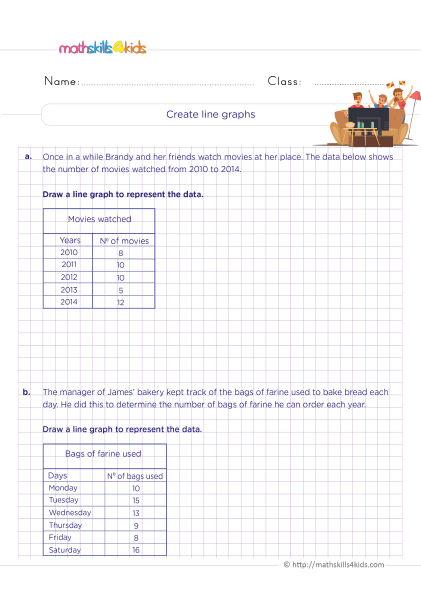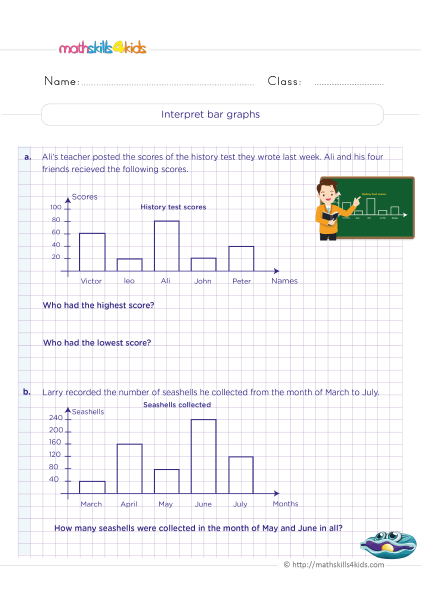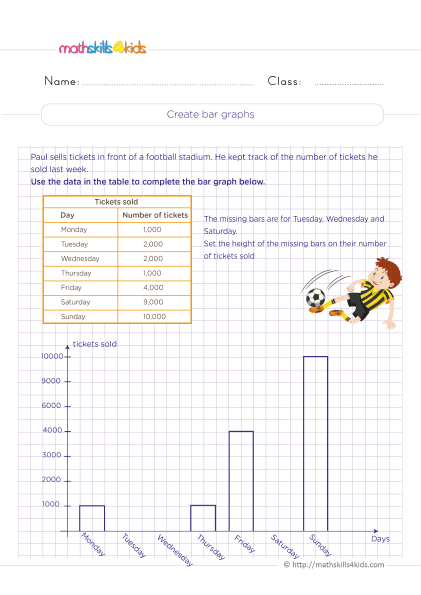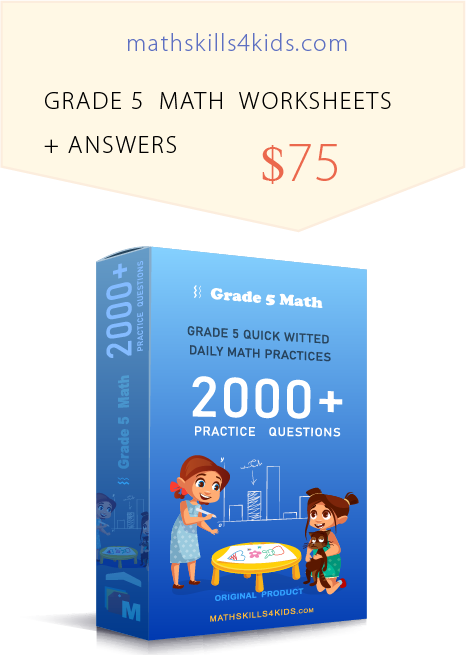Grade 5 coordinate graphing worksheets: Data analysis activities
Hello, teachers and parents! Get ready to help your students map out some math easily with these stimulating Grade 5 coordinate graphing worksheets. This article consists of fun amazing data analysis activities and worksheets that will uplift 5th grader’s skills in identifying points, locating coordinates, and finding out the distance between them
-
After going through this math article, you’ll enjoy teaching graphing to your 5th graders on a coordinate plane. But before then, let’s find out what this article has for you:
- What are coordinate graphing worksheets?
- Importance of teaching data analysis in 5th grade
- Benefits of using coordinate graphing worksheets
- How to introduce coordinate graphing to 5th graders
- A step-by-step guide to completing coordinate graphing worksheets
- Common mistakes to avoid when teaching coordinate graphing
- Fun activities and games to reinforce coordinate graphing skills
- Additional resources for teaching coordinate graphing
- Success stories and testimonials from teachers and students
- Conclusion: Empowering your 5th graders with data analysis skills
Unleash your 5th graders' inner data analyst with our coordinate graphing worksheets.
Are you looking for a fun and educational way to unleash your 5th graders' inner data analyst? Look no further! Mathskills4kids’ coordinate graphing worksheets are designed to engage and challenge your students while teaching them important math skills.
Whether your students are beginners or already have some experience with coordinate graphing, Mathskills4kids’ worksheets offer a range of difficulty levels to suit every need. With colorful and captivating graphs, your students will learn to plot points, draw lines and shapes, and analyze data like never before.
Our worksheets are educational and fun, keeping your students motivated and excited to learn. So, why wait? Take your 5th graders' math skills to the next level and unleash their inner data analyst with our amazing coordinate graphing worksheets.
-
BROWSE THE WEBSITE
-
DOWNLOAD FREE WORKSHEETS
-
-
5th GRADE MATH TOPICS
- Number sense
- Addition and subtraction
- Multiplication
- Division
- Exponents
- Number theory
- Decimals
- Add & subtract decimals
- Multiply decimals
- Divide decimals
- Fractions & mixed numbers
- Add & subtract fractions
- Multiply fractions
- Divide fractions
- Mixed operations
- Problems solving
- Ratios and rates
- Percentages
- Money Math
- Number sequences
- Coordinate graph
- Variable expressions
- Data and Graphs
- Probability and statistics
- Telling time
- Unit of measurements
- 2D figures
- Triangles & quadrilaterals
- Symmetry & transformations
- 3D figures
- Geometric measurements
-
-
Create line graphs - How to draw a line graph using the data in the table
 Print it...
Print it...
-
Interpreting bar graph or chart - How do you interpret a graph?
 Print it...
Print it...
-
Creating bar graphs - How to draw a bar graph using the data in the table
 Print it...
Print it...
-
Create pictographs by completing the missing data
 Print it...
Print it...
-
Reading line plots with whole numbers - Interpreting line plots
 Print it...
Print it...
-
Make line plots and interpret data - Line plots with fractions practice
 Print it...
Print it...
-
Create line graphs - How to draw a line graph using the data in the table
-
Buying is supporting us!
Buy Now...
-
-
What are coordinate graphing worksheets?
Coordinate graphing worksheets are a valuable teaching tool that helps students understand and apply mathematical concepts related to coordinate systems. In simple terms, coordinate graphing involves plotting points on a grid, where the horizontal axis represents the x-coordinate and the vertical axis represents the y-coordinate. By connecting these points, students can create various shapes and lines, which can then be used to analyze and interpret data.
Using coordinate graphing worksheets, students learn how to read and interpret graphs, identify patterns, and make predictions based on the data represented. These worksheets provide a hands-on learning approach, where students plot points and analyze the results in no time. This helps them develop their math skills and enhances their critical thinking and problem-solving abilities.
-
Importance of teaching data analysis in 5th grade
Teaching data analysis in 5th grade is crucial for several reasons. First and foremost, it helps students develop essential skills that are applicable in various real-world scenarios. In today's data-driven world, analyzing and interpreting data is a valuable skill beyond classroom boundaries. By introducing data analysis early, students are better equipped to make informed decisions, solve problems, and communicate their findings effectively.
Moreover, teaching data analysis in 5th grade lays the foundation for more advanced mathematical concepts in the future. With mastery to read and interpret graphs, students are better prepared for algebra, statistics, and calculus. It also helps them better understand mathematical concepts and enhances their overall mathematical fluency.
-
Benefits of using Mathskills4kids’ Grade 5 coordinate graphing worksheets
Using Mathskills4kids’ Grade 5 coordinate graphing worksheets offers numerous benefits for students and teachers. Here are some key advantages:
- Engagement and motivation: Mathskills4kids’ Grade 5 coordinate graphing worksheets provide a dynamic and interactive learning experience that captures students' attention and keeps them engaged. The visual nature of graphs and the hands-on nature of plotting points make learning math exciting and fun.
- Hands-on learning: Our coordinate graphing worksheets promote active learning, allowing students to plot points and observe the results physically. This hands-on approach helps students internalize mathematical concepts and better understand the subject matter.
- Critical thinking and problem-solving: Mathskills4kids’ Grade 5 coordinate graphing requires students to analyze data, identify patterns, and make connections. This cultivates critical thinking and problem-solving skills, as students are challenged to interpret the information presented and draw meaningful conclusions.
- Differentiated instruction: Our coordinate graphing worksheets come in various difficulty levels, allowing teachers to differentiate instruction based on students' needs. Whether students are beginners or advanced, these worksheets can be tailored to provide an appropriate level of challenge.
- Integration of multiple skills: Our Grade 5 coordinate graphing worksheets provide an opportunity to integrate multiple skills, such as math, reading comprehension, and data analysis. This interdisciplinary approach fosters a holistic understanding of the subject matter and helps students make connections between different areas of learning.
-
How to introduce coordinate graphing to 5th graders
Introducing coordinate graphing to 5th graders requires a systematic and step-by-step approach. Here's a guide from Mathskills4kids.com to help you get started:
- Introduce the coordinate plane: Begin by explaining the concept of a coordinate plane and its two axes: the x-axis and the y-axis. Use visual aids, such as a large grid on the board, to illustrate the concept. Show students how the axes intersect at the origin (0, 0) and how the positive and negative numbers are represented.
- Teach plotting points: Once students understand the coordinate plane, teach them how to plot points. Start with simple examples and guide them through identifying the x-coordinate and the y-coordinate and then locating the point on the grid. Provide ample opportunities for practice and reinforcement.
- Introduce line segments and shapes: After students grasp the concept of plotting points, introduce the idea of connecting these points to create line segments and shapes. Start with basic shapes such as squares and rectangles and gradually progress to more complex figures. Encourage students to experiment and explore different combinations of points.
- Explore real-world examples: Incorporate real-world examples and applications to make coordinate graphing more relatable. For instance, show students how coordinate graphing is used in mapping, navigation, and even video game design. This helps students understand the practical relevance of the concepts they are learning.
- Provide guided practice: Offer plenty of guided practice opportunities to reinforce students' understanding of coordinate graphing. This can be done through worksheets, interactive activities, and small group discussions. Monitor student's progress closely and provide feedback and support as needed.
By following these steps, you can effectively introduce coordinate graphing to your 5th graders and set them on the path to becoming confident data analysts.
-
A step-by-step guide to completing coordinate graphing worksheets
Completing coordinate graphing worksheets involves a series of steps that students must follow. Here's a step-by-step guide to help them navigate through the process:
- Read the instructions: Begin by carefully reading the instructions provided on the worksheet. Make sure to understand the objectives and requirements of the task.
- Identify the coordinates: Look for the given coordinates in the instructions. These coordinates represent the points that need to be plotted on the graph.
- Plot the points: Using a pencil or a marker, plot the given points on the coordinate plane. Remember to locate the x-coordinate on the horizontal axis and the y-coordinate on the vertical axis.
- Connect the points: Once all the points are plotted, connect them in the order specified in the instructions. This will create lines, shapes, or patterns on the graph.
- Analyze the graph: Take a moment to analyze the graph and observe any patterns or trends. Look for symmetry, straight lines, curves, or any other characteristics that may be relevant to the task.
- Answer the questions: Finally, answer any questions or complete any tasks associated with the graph. This may involve interpreting the data, making predictions, or solving problems based on the information provided.
Remember to approach each worksheet with a curious and analytical mindset. Mathskills4kids’ Grade 5 coordinate graphing worksheets are not just about completing tasks; they are an opportunity to explore and discover the power of data analysis.
-
Common mistakes to avoid when teaching coordinate graphing
Teaching coordinate graphing can be challenging, especially when students are first introduced to the concept. Here are some common mistakes to avoid when teaching coordinate graphing to ensure a smooth learning experience:
- Skipping the basics: It's essential to lay a strong foundation by teaching the basics of coordinate graphing, including the coordinate plane, plotting points, and connecting lines. Skipping these fundamental concepts can lead to confusion and hinder students' progress.
- Rushing through practice: While providing ample practice is essential, rushing through worksheets without sufficient guidance can be counterproductive. Make sure to offer support and feedback as students work through the problems, addressing any misconceptions or difficulties they may have.
- Neglecting real-world applications: Coordinate graphing becomes more meaningful when students understand its real-world applications. Incorporate examples from everyday life, such as navigation, map reading, and even art, to help students see the relevance and practicality of the concepts they are learning.
- Focusing solely on accuracy: While accuracy is essential, it's equally crucial to encourage creativity and exploration. Coordinate graphing allows for multiple interpretations and approaches, so encourage students to think outside the box and experiment with different combinations of points.
- Not providing enough scaffolding: Coordinate graphing can be challenging for some students, especially those who struggle with spatial reasoning or visualizing abstract concepts. Provide scaffolding and support, such as using graph paper or providing pre-drawn grids, to help these students build confidence and overcome obstacles.
By avoiding these common mistakes, you can create a positive and engaging learning environment that maximizes students' understanding and enjoyment of coordinate graphing.
-
Fun activities and games to reinforce coordinate graphing skills
Reinforcing coordinate graphing skills doesn't have to be limited to worksheets and assignments. Here are some fun activities and games that can make learning even more enjoyable:
- Coordinate treasure hunt: Create a treasure map with various coordinates marked on it. Students can work in pairs or small groups to locate the hidden treasures by following the coordinates. This activity reinforces coordinate graphing skills and promotes teamwork and collaboration.
- Graphing mystery pictures: Provide students with worksheets that contain hidden pictures represented by a series of coordinates. A picture will gradually emerge as students plot the points and connect the lines. This activity combines art and math, making it both creative and engaging.
- Coordinate battleship: Adapt the classic Battleship game to reinforce coordinate graphing skills. Each player has a grid and takes turns calling out coordinates to locate the opponent's ships. This game helps students practice accuracy and precision while having a blast.
- Graphing relay race: Divide the class into teams and set up stations with different graphs and coordinates. Each team member takes turns running to the station, plotting the points, and returning to tag the next teammate. The first team to complete all the graphs correctly wins the relay race.
- Coordinate graphing art project: Assign students a creative project that involves coordinate graphing. For example, they can design artwork by plotting points and connecting lines on a graph. This activity allows students to showcase their creativity while practicing coordinate graphing skills.
Bonus: Additional resources for teaching coordinate graphing
In addition to Mathskills4kids’ Grade 5 coordinate graphing worksheets, several other resources are available to support your teaching and enhance students' learning experience.
Here are a few recommendations:
- Online interactive tools: Numerous websites and online platforms offer interactive coordinate graphing tools. These tools allow students to practice plotting points, drawing shapes, and analyzing data in a virtual environment. Some popular options include Desmos, GeoGebra, and Math Playground.
- Math apps: Many educational apps provide interactive games and activities focusing on coordinating graphing. These apps can be accessed on tablets and smartphones, making them easily accessible and engaging for students. Some popular math apps for coordinate graphing include SplashLearn, Prodigy, and Khan Academy.
- Teacher resources: Look for teacher resources and lesson plans specifically designed for teaching coordinate graphing. These resources often include detailed explanations, step-by-step instructions, and additional practice problems. Websites such as Teachers Pay Teachers, and Math-Drills.com offer a wide range of free and paid resources for coordinate graphing.
- Books and workbooks: Consider incorporating books and workbooks that cover coordinate graphing into your classroom library. These resources can provide additional practice and reinforcement for students. Some recommended titles include "Graphing Points on a Coordinate Plane" by Rebecca Wingard-Nelson and "Coordinate Grid: Battleship" by Jennifer Culp.
Utilizing these additional resources can enhance your teaching and provide students with various learning opportunities that cater to different learning styles and preferences.
-
-
Thank you for sharing the links of MathSkills4Kids.com with your loved ones. Your choice is greatly appreciated.
Conclusion: Empowering your 5th graders with data analysis skills
In conclusion, Grade 5 coordinate graphing worksheets offer a powerful tool for empowering your 5th graders with data analysis skills. These worksheets promote critical thinking, problem-solving, and mathematical fluency by engaging students in hands-on activities.
They provide a solid foundation for understanding coordinate systems, reading graphs, and interpreting data. With the help of additional resources and fun data analysis activities, you can create an engaging and interactive learning environment that inspires your students to become confident data analysts.
So, unleash your 5th graders' inner data analyst today and watch them soar to new heights in their math journey!
